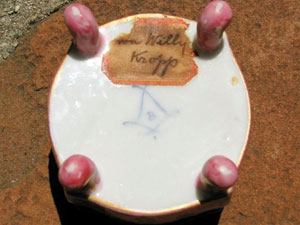 Susanne sent me pictures of a lovely little porcelain dresser box with ormolu surrounding the lid joint. She inherited it from her German grandmother. Under the box we see a little label verso that says “von Willy Kropp.” I did an informal search of Willy Kropp and found a third-generation Volkswagen repairman who stayed in business since 1970 in Baden-Baden in Southern Germany. Willy inherited the shop from his grandfather and father. I wonder if Susanne’s grandmother lived in the Baden-Baden area? How sweet of Willy to gift a probably expensive and intimate gift at the time!
Susanne sent me pictures of a lovely little porcelain dresser box with ormolu surrounding the lid joint. She inherited it from her German grandmother. Under the box we see a little label verso that says “von Willy Kropp.” I did an informal search of Willy Kropp and found a third-generation Volkswagen repairman who stayed in business since 1970 in Baden-Baden in Southern Germany. Willy inherited the shop from his grandfather and father. I wonder if Susanne’s grandmother lived in the Baden-Baden area? How sweet of Willy to gift a probably expensive and intimate gift at the time!
Now for the appraising:
The crossed swords on the bottom imply the famous Meissen factory. But crossed swords represented many factories, such as Sevres, Berlin and Old Paris Porcelain manufacturers.
Susanne’s box features a mother and child in portrait on the lid. In fact it’s made of Old Paris Porcelain, also called “Vieux Paris.” This doesn’t refer to one factory but more than 30 and hundreds of artisans around Paris from 1750 to the reign of Napoleon III, called the Second French Empire (1852-70).
A little history of porcelain in Paris:
In the mid-18th century, King Louis XV of France so loved porcelain that he moved the existing Vincennes factory to Sevres and enacted laws restricting the manufacture of porcelain anywhere else in France. Incensed Paris’ potters lobbied for a relaxation of these laws. Louis met them halfway and agreed to allow Paris’ potters to create monochrome pieces without decoration only — very boring and unsalable in those days.
Enter Marie Antoinette who also adored porcelain. Artisans from Sevres stole porcelain molds and materials to work under her patronage. However, her patronage ended on Oct. 16, 1793, when she was beheaded, and the French Revolution took care of noble privilege and exclusive rights to porcelain.
The styles in Paris porcelain reflected the times, therefore I date this gift of Willy’s to the late 19th century, when nostalgia and sentimentalism ruled, especially the “home is where the heart is” sentiment. Notice the mother and child on the box as opposed to what early styles dictated, like a beautiful, young courting couple.
This porcelain dresser box was a necessity on a lady’s dressing table, holding hair pins, powders or buttons. These were an appropriate gift from an interested gentleman, just intimate enough to seem suggestive.
Susanne’s box? It’s worth $400.